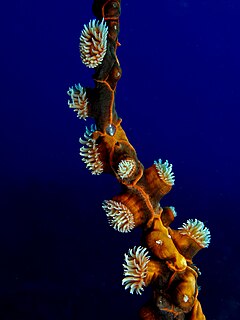
Tube-dwelling anemones or ceriantharians look very similar to sea anemones but belong to an entirely different subclass of anthozoans. They are solitary, living buried in soft sediments. Tube anemones live inside and can withdraw into tubes, which are composed of a fibrous material made from secreted mucus and threads of nematocyst-like organelles known as ptychocysts. Within the tubes of these ceriantharians, more than one polyp is present, which is an exceptional trait because species that create tube systems usually contain only one polyp per tube. Ceriantharians were formerly classified in the taxon Ceriantipatharia along with the black corals but have since been moved to their own subclass, Ceriantharia.

Edwardsia is a genus of sea anemones, the type of the family Edwardsiidae. They have eight mesenteries and live in tubes in the sand. The name, in New Latin, commemorates the French zoologist Henri Milne-Edwards.

Corallimorpharia is an order of marine cnidarians closely related to stony or reef building corals (Scleractinia). They occur in both temperate and tropical climates, although they are mostly tropical. Temperate forms tend to be very robust, with wide and long columns, whereas tropical forms tend to have very short columns with a wide oral disc and very short tentacles. The tentacles are usually arranged in rows radiating from the mouth. Many species occur together in large groups, although there are recorded instances of individuals. In many respects, they resemble the stony corals, except for the absence of a stony skeleton. Morphological and molecular evidence suggests that they are very closely related to stony corals.

Alicia is a genus of sea anemones in the family Aliciidae and contains the following species:

Nemanthus annamensis, commonly known as the gorgonian wrapper, is a species of sea anemone found in central Indo-Pacific waters.

Amphianthus is a genus of sea anemones. It is the only genus in the monotypic family Amphianthidae.

Anthothoe is a genus of sea anemones in the family Sagartiidae.

Bunodactis is a genus of sea anemones in the family Actiniidae.

Epiactis is a genus of sea anemones in the family Actiniidae. There are about nineteen recognised species and the type species is Epiactis prolifera.

Isozoanthus is a genus of anemone-like anthozoans in the order Zoantharia.

Parazoanthus is a genus of anemone-like anthozoans in the order Zoantharia.

Cerianthus is a genus of tube-dwelling anemones in the family Cerianthidae. Members of the genus are found worldwide. They are predators, scavengers and omnivores.

Zoanthus is a genus of anthozoans in the family Zoanthidae. It is the type genus for its family and order.

Palythoa is a genus of anthozoans in the order Zoantharia.
Ceriantheomorphe is a genus of tube-dwelling anemones in the family Cerianthidae.

Arachnanthus is a genus of tube-dwelling anemones in the family Arachnactidae. Members of the genus are found worldwide.

Actinostola is a genus of sea anemones in the order Actiniaria. All members of this genus are deep-sea species, with some occurring at hydrothermal vents.

Diadumene is a genus of sea anemones. It is the only genus in the monotypic family Diadumenidae.

Pachycerianthus is a genus of marine tube-dwelling anemones in the family Cerianthidae.
Actinernidae is a family of sea anemones. It contains the following genera and species:


















